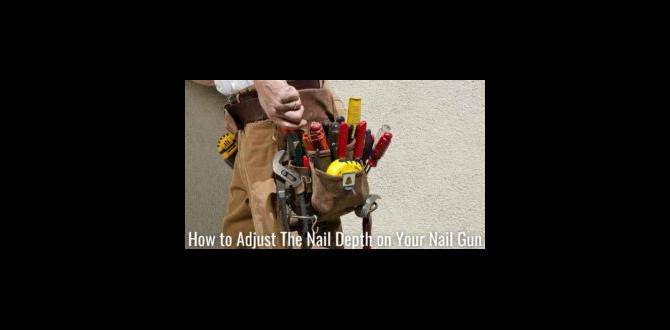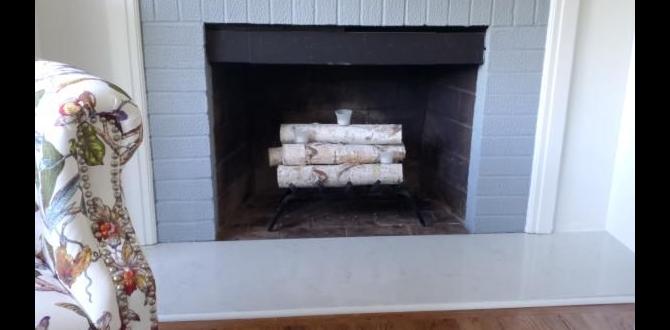Quick Summary: Nails bend when using a nail gun primarily due to incorrect air pressure, the wrong type of nail for the material, misaligned nail gun, or shooting into dense knots. Adjusting your nail gun’s settings and choosing the right fasteners for your job will help prevent this common frustration.
Hey there DIYers! Jack Shaffer here from Nailerguy. Bent nails are one of those little project headaches that can really slow you down. You’re excited, you’re ready to build something awesome, and then… thwack… followed by that disheartening clunk of a bent nail. It’s frustrating, right? But don’t worry, most of the time, it’s a simple fix. We’re going to dive deep into why this happens and how to avoid it so you can get back to building with confidence. We’ll cover everything from your nail gun’s settings to the materials you’re working with.
Table of Contents
Understanding the Anatomy of a Bent Nail
Seeing a bent nail can feel like a mystery, but usually, it’s a straightforward mechanical issue. Think of it like this: a nail is designed to penetrate wood cleanly. When it bends, something interfered with that clean path or the force behind it wasn’t right. It’s not usually the nail’s fault; it’s more about how it’s being driven.
The good news is that once you understand the common culprits, you can prevent bent nails almost entirely. This guide is all about demystifying those bent nails and giving you the know-how to drive them straight and true every time. We’ll break down the common causes one by one, so you can identify the problem and fix it on the fly during your next project.
The Top Culprits: Why Nails Bend During Nailing
Let’s get down to the nitty-gritty. Several factors can lead to bent nails, and understanding them is your first step to fixing the problem. We’re going to explore each of these in detail, helping you diagnose what might be happening on your job site.
1. Incorrect Air Pressure (PSI)
This is perhaps the most common reason for bent nails, especially when using a pneumatic (air-powered) nail gun. Your nail gun needs a specific amount of air pressure to drive the nail home with the right force. Too little pressure, and the nail might not fully seat, leaving it vulnerable to bending if it hits resistance. Too much pressure, and the nail can be driven with so much force that it deforms itself, especially if it strikes a harder part of the wood or if the nail gun isn’t perfectly perpendicular to the surface.
What PSI Means for You
Every nail gun and fastener combination performs best within a certain PSI range. This range is usually listed in your nail gun’s manual. It’s crucial to consult this manual. For example, a framing nailer driving large nails might need 80-120 PSI, while a brad nailer for trim might operate happily between 70-100 PSI.
- Too Low PSI: Inadequate power means the nail might not penetrate fully. If it hits a knot or a harder section of wood, it can deflect and bend because it doesn’t have enough force to power through.
- Too High PSI: Excessive force can sometimes cause the nail to buckle on impact, especially if the nail gun’s magazine isn’t perfectly aligned or if the nail isn’t hitting the surface squarely. It can also drive the nail too deeply, causing stress that leads to bending.
Pro Tip: Always start with a lower PSI setting and gradually increase it until the nail drives effectively without over-penetrating. A good rule of thumb is to listen to the “thwack.” It should be a solid sound, not a weak tap or an explosive boom.
2. The Wrong Nail for the Job
Nails come in all shapes, sizes, and thicknesses, designed for specific tasks. Using a nail that’s too thin or too short for the material you’re fastening is a recipe for disaster. For instance, trying to use a fine brad nail to secure a thick framing joist is a guarantee of bent nails and a weak connection. The nail simply isn’t built to handle that kind of load or penetration depth into denser materials.
Matching Nails to Materials
Consider the strength and density of the wood you’re working with. Softwoods like pine might allow for a wider range of fasteners, but hardwoods like oak or maple require stronger, often thicker nails, or even screws, to penetrate properly without bending.
Here’s a quick look at common nail types and their uses:
| Nail Type | Gauge (Thickness) | Common Uses | Risk of Bending if Mismatched |
|---|---|---|---|
| Brad Nail | Thin (e.g., 18-gauge) | Trim, molding, delicate woodworking, craft projects | High if used in hardwoods or for structural connections |
| Finish Nail | Medium (e.g., 15-16 gauge) | Casing, baseboards, chair rails, furniture assembly | Moderate if used in very dense wood or for framing |
| Nail Gun (Common Framing/Common Nail) | Thicker (e.g., 8-gauge, 3.5-inch) | Framing walls, decks, fences, structural projects | Low for intended use; could bend if driven into extremely dense knots or through metal |
| Siding Nail | Medium to Thick (e.g., 15-gauge) | Attaching siding materials (vinyl, wood, fiber cement) | Moderate if used incorrectly for specific siding types or in dense subflooring |
Always check the specifications for your project or the material you’re fastening. Using nails rated for the task ensures they have the strength and size to penetrate without buckling.
3. Nail Gun Alignment and Angle
This one’s all about technique. If your nail gun isn’t held completely perpendicular to the surface of the wood, the nail won’t enter straight. Imagine trying to push a pencil through paper at an angle – it’s more likely to bend or tear the paper. The same principle applies to nails and wood.
The “Square Deal”
The nosepiece of your nail gun (the part that sits against the wood) should be placed squarely on the surface before you pull the trigger. This ensures the nail fires straight into the material.
- Angle of Incidence: Even a slight angle can cause the nail to meet resistance sideways as it enters the wood. This friction and sideways force can easily bend the nail, especially if the wood is hard.
- Off-Center Nailing: If the contact point isn’t centered on the nose of the gun, the nail can be driven at a slight skew from the start.
Best Practice: Always ensure the nail gun is flush and perpendicular to the workpiece. Some nail guns have safety contact tips that prevent firing unless pressed against the surface – this feature helps with proper alignment. But even with these, consciously place the gun square to the material.
4. Hitting Knots, Nails, or Dense Grain
Wood isn’t uniform. It has knots, areas of denser grain, and sometimes, you might accidentally try to nail into a spot where another fastener already exists. These are like speed bumps for your nail.
Navigating Wood’s Obstacles
A knot is a hardened, often denser part of the wood where a branch once grew. Trying to drive a nail directly through the center of a knot can be tough. Dense grain areas, especially in hardwoods, offer significant resistance.
- Knots: These are particularly troublesome. If your nail hits a knot at an angle or with insufficient force, it’s very likely to bend. Driving nails slightly to the side of a knot, or into an area of softer grain, is often a better strategy.
- Existing Fasteners: While less common, if you’re working on a piece that’s already been nailed, you might hit an old nail or screw shank. This is a guaranteed way to bend your new nail.
- Dense Wood Grain: Some woods, like oak or maple, have very tight, dense grain. Even with the correct PSI and nail type, you might encounter more resistance. In extreme cases, it might require pre-drilling a pilot hole, though this is rare for most nail gun applications.
Tip for Tough Spots: If you consistently hit knots, try repositioning your nail slightly. If you’re working with very dense hardwoods and encountering frequent bending, consider using a slightly higher gauge nail or even switching to screws for critical structural points.
5. Nail Gun Malfunction or Wear
Like any tool, nail guns can develop issues over time. A small problem can lead to a cascade of fastening failures, including bent nails.
Common Wear-and-Tear Issues
- Worn Driver Blade: The driver blade is the part inside the nail gun that strikes the nail head. If this blade becomes dull, chipped, or bent itself, it might not hit the nail squarely or with enough force, leading to bending.
- Springs and Seals: Internal springs can weaken, and seals can degrade, affecting the consistent power delivery of the nail gun.
- Magazine Issues: If the nail magazine or feeder mechanism isn’t properly aligned, it can present nails to the driver blade at a slight angle.
Maintenance is Key: Regularly clean and lubricate your nail gun according to the manufacturer’s instructions. Inspect the driver blade for any damage. If you suspect a malfunction, it’s best to have it inspected by a professional or consult your manual for troubleshooting steps. Visit a resource like OSHA’s guidelines on tools and machinery for best practices in tool safety and maintenance.
6. Nail Collation or Quality Issues
The way nails are held together in a strip or coil (called collation) can also play a role. Poorly manufactured nails or damaged collation can cause them to jam or feed incorrectly.
The Nail Strip Matters
- Damaged Strips: If the strip of nails is bent, individual nails might not sit correctly in the magazine, leading to misfires or angled drives.
- Poor Collation Glue/Wire: Sometimes, the glue or wire used to hold the nails together can interfere with the firing mechanism or cause the nail to snap or bend as it’s seated.
- Nail Quality: While less common with reputable brands, sub-par nails might have inconsistent heads or shafts that are more prone to bending.
What You Can Do: Always inspect your nail strips before loading them into the gun. If you notice any damage, set that strip aside. Stick to well-known, reputable brands for your fasteners. If you start experiencing frequent bending with a new box of nails, it might be worth trying a different brand.
Troubleshooting Common Scenarios: Step-by-Step Fixes
Now let’s put this knowledge into action. When you’re faced with a bent nail, here’s a practical, step-by-step approach to figure out what’s going wrong and how to fix it.
Step 1: Assess the Bent Nail
Take a look at the nail. How is it bent? Is it a gentle curve, or is it sharply kinked? Does it seem to have bent right at the entry point, or further in?
- Gentle Curve: Often indicates consistent resistance or slightly too much force.
- Sharp Kink: Usually means the nail hit a significant obstruction (like a knot) or the gun was misaligned at impact.
- Bent at Entry: Likely a gun alignment or pressure issue from the start.
- Bent Further In: Suggests hitting internal wood resistance like a knot or dense grain.
Step 2: Check Your Nail Gun Settings
Before you even think about shooting another nail, check the basics:
- Air Pressure (PSI):
- Disconnect the air hose from the nail gun.
- Check the regulator on your air compressor or inline regulator.
- If you don’t know the correct PSI, consult your nail gun’s manual. A general starting point for many common tasks is around 80-100 PSI.
- Re-establish the connection.
- Depth Adjustment (if applicable): Many nail guns have a dial or collar near the nosepiece to control how deep the nail is driven. Ensure this is set appropriately for your material. Too deep can cause stress, too shallow means it’s not seated.
Step 3: Verify Your Fasteners
Are you using the right nail for the job?
- Nail Type & Size: Confirm the gauge and length of the nails you’re using are appropriate for the thickness and density of the wood. For example, are you using 16-gauge finish nails for 3/4-inch trim, or did you accidentally grab a 5/8-inch nail?
- Nail Collation: Check the strip of nails. Are they clean, straight, and properly seated in the strip? If the strip looks damaged, try a new one.
Step 4: Position the Nail Gun Correctly
This is crucial for consistent results:
- Square Alignment: Place the nose of the nail gun flat and perpendicular to the surface where you intend to drive the nail.
- Firm Contact: Apply gentle but firm pressure to ensure the safety contact tip (if your gun has one) is fully engaged and the gun is stable against the workpiece.
- Trigger Pull: Squeeze the trigger smoothly and evenly.
Step 5: Identify Obstructions within the Wood
If problems persist after checking settings, fasteners, and alignment:
- Visual Inspection: Look closely at the area where the nail bent. Can you see a knot, a split in the wood, or evidence of another fastener?
- Tap Test: Sometimes, tapping lightly on the wood surface with a hammer where you intend to nail can reveal a knot or a particularly dense spot by its sound.
- Adjust Nailing Spot: If you suspect an obstruction, try firing the nail just a centimeter or two away from the suspected spot.
Step 6: Consider Tool Maintenance
If you’ve tried everything else and still encounter frequent bending:
- Inspect Driver Blade: Safely disconnect the air, remove the magazine, and peer into the barrel. Can you see the driver blade? Does it look straight and undamaged? (Consult your manual for safe inspection procedures).
- Lubrication: Has the tool been lubricated recently according to the manufacturer’s recommendations?
- Professional Check: If the tool is older or shows signs of wear, it might be time for professional servicing. For advanced maintenance tips even for beginners, Family Handyman offers practical advice on maintaining tools like nail guns.
When Do I Need to Worry? Signs of a Bigger Problem
While bent nails are usually a minor annoyance, sometimes they can signal a more significant issue. Understanding these signs can save you time and prevent potential safety hazards.
- Consistent Bending with Correct Settings: If you’ve meticulously followed all the steps above, double-checked your PSI, used the right nails, and ensured perfect alignment, yet nails still consistently bend, the problem might be with the nail gun itself or the air system.
Potential Larger Issues Include:
- Weak Driver Blade: A chipped or bent driver blade won’t hit the nail squarely.
- Air Leaks: Significant air leaks could reduce the driving power below effective levels.
- Faulty O-rings or Seals: Worn internal components can lead to inconsistent power.
- Nail Gun Firing Irregularly: If the gun isn’t firing every time, or if it fires with wildly varying force, this is a clear indicator of a mechanical issue.
- Nails Not Seating Flush: If nails are consistently proud of the surface or sinking too deep, it points to depth control or power issues.
- Unusual Noises: Any grinding, hissing (beyond normal exhaust), or clunking sounds from the nail gun itself should be investigated.
If you experience any of these consistent problems, it’s best to stop using the tool and consult your user manual for troubleshooting, or contact the manufacturer for support. For many DIYers,


